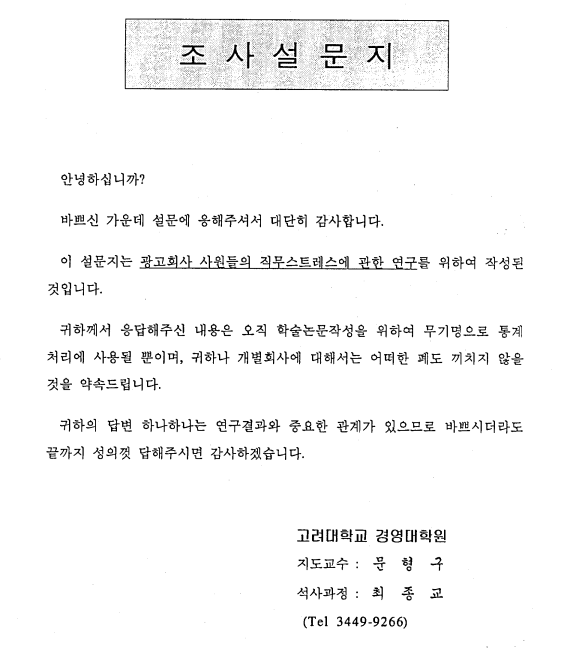
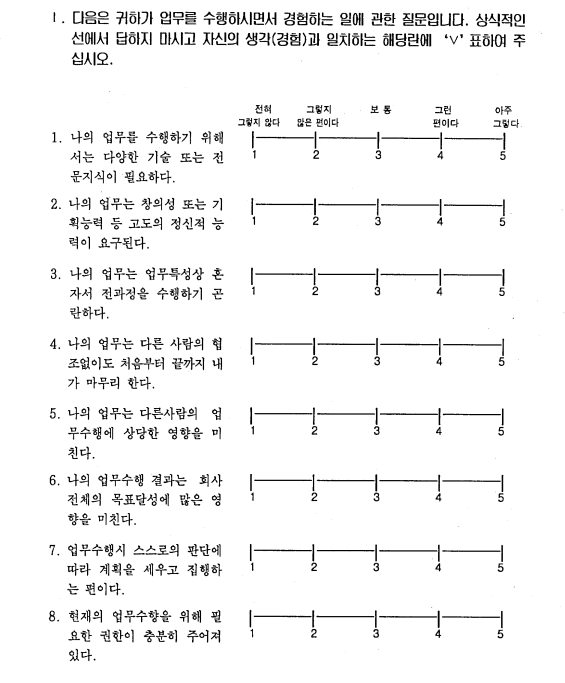
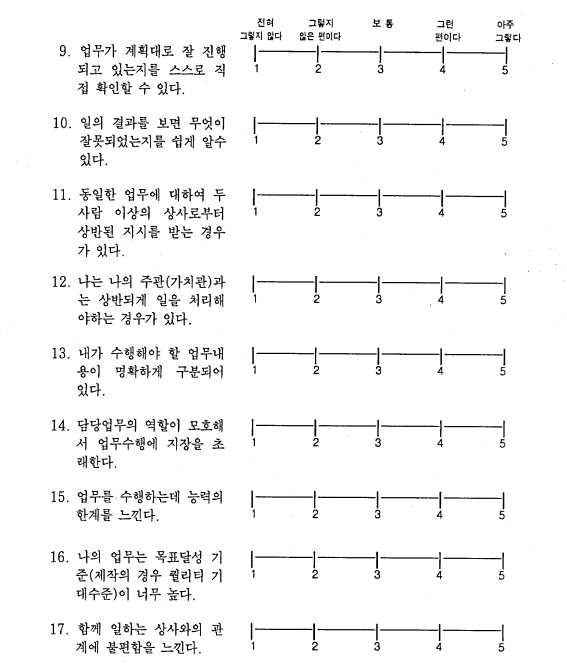
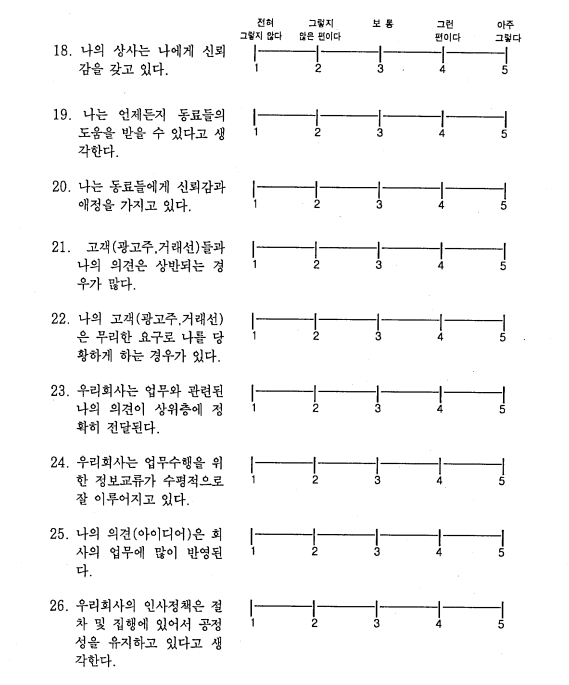
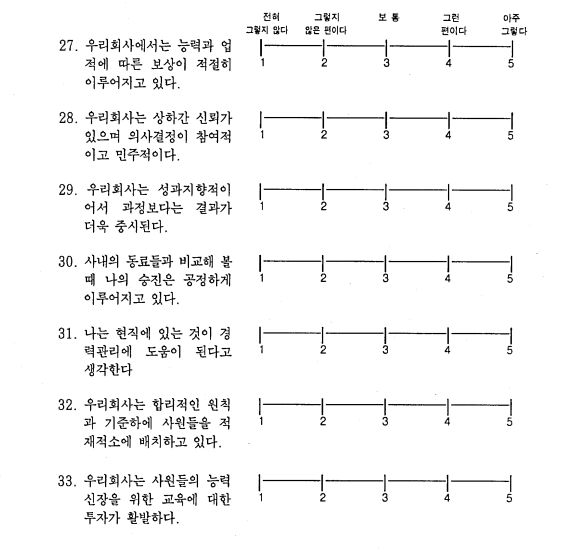
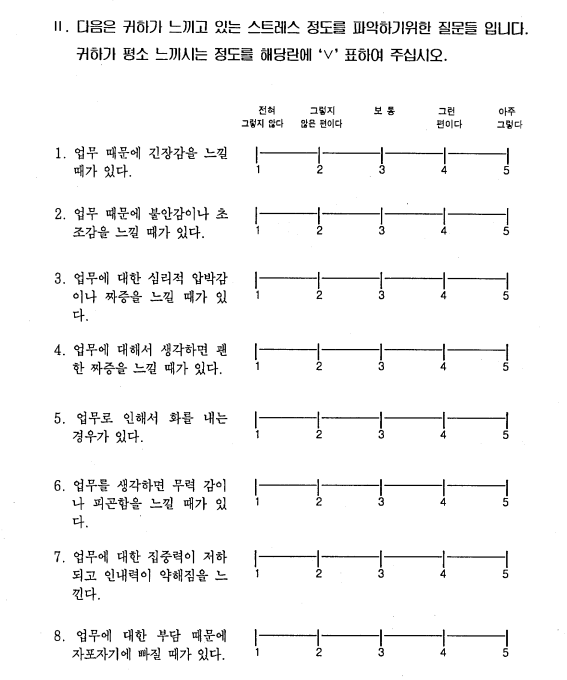

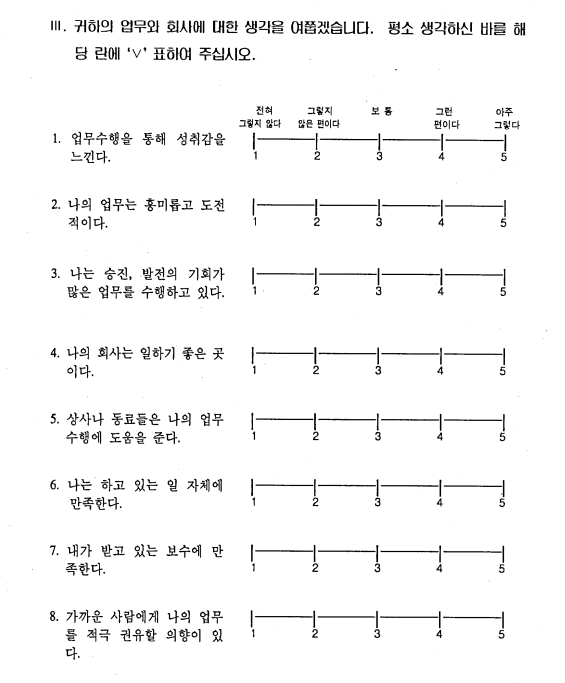
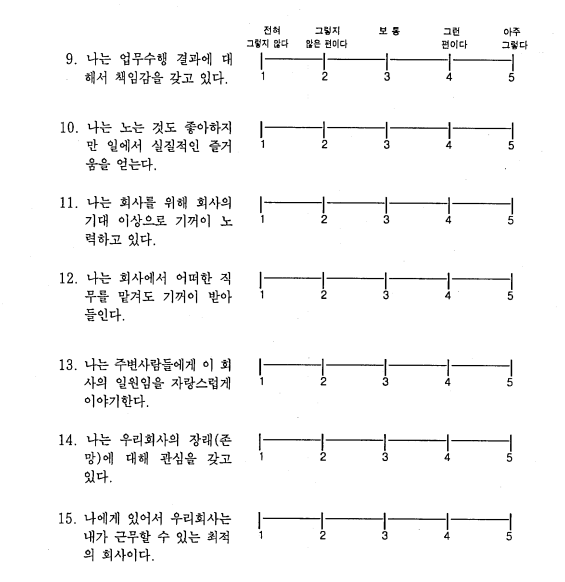
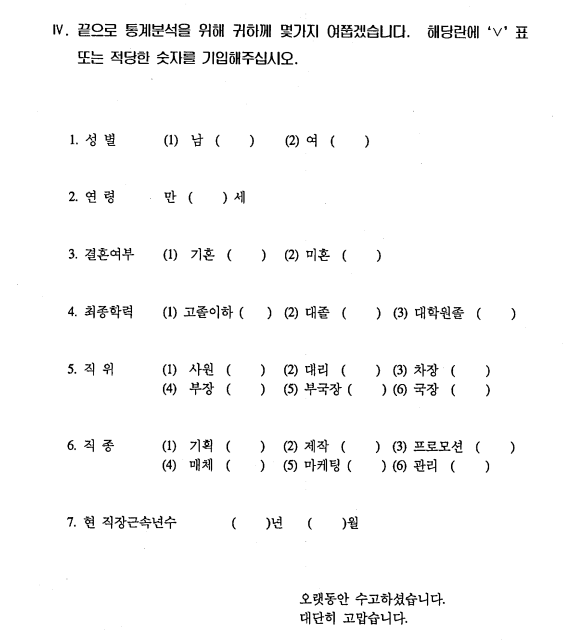
제 5장 결 론
제 1절 연구결과의 요약
연구자는 현대인이 일상생활에서 수없이 경험하는 스트레스 현상에 주목하 고 특히 조직내에서의 직무스트레스 원천은 무엇이며, 개인차에 따른 직무스트레스의 지각정도, 직무스트레스 결과로서의 조직 유효성과의 영향관계는 어떠 한가에 촛점을 맞추고 본 연구를 수행하였다. 연구의 대상으로는 최근 산업의 규모가 급격하게 성장하고 있으며, 직무의 내용이 창의성을 요하고 프로젝트적 이어서 일반적으로 '스트레스 정도가 높을 것이다'라고 인식되고 있는 광고산업을 그 대상으로 하였다. 국내 9대 광고회사 사원을 대상으로 실시된 연구결과를 요약하면 다음과 같다.
첫째, 광고회사 사원들의 직무스트레스 지각정도는 전반적으로 보통수준으로 나타났다. 직종별로는 기획 및 제작직종이 비교적 스트레스지각 수준이 높았고, 관리, 매체직종이 낮았다. 직위에 있어서는 부장, 차장, 대리급의 순으로 스트레스 수준이 높았으며, 사원, 국장급은 낮았다. 근속연수별로는 2∼4년차시기에 가장 높은 직무스트레스 지각을 보였고 1년미만의 경우가 가장 낮았다. 그 밖에 남자가 여자보다, 기혼자가 미혼자보다, 학력수준이 높을수록 직무스트레스 지각정도가 높았으나, 통계적으로는 크게 유의하지 않았다.
둘째, 광고회사 사원들에게 전반적인 직무스트레스 요인으로 작용하고 있는 것은 인간관계요인, 역할관련요인, 직무특성요인인 것으로 밝혀졌다. 인간관계 요인은 직무스트레스와 負(-)적인 관계를 나타내었고, 역할관련요인은 正(+)적인 관계를 나타내었다. 즉 인관관계가 좋을수록 직무스트레스 수준이 낮았고, 역할이 과다하고 갈등을 느낄수록 직무스트레스 지각정도가 높았다. 광고인들은 특히 역할과다, 고객관계에서 높은 직무스트레스 지각을 보였으며, 역할갈등, 동료관계, 교육지원의 부족 등에서도 비교적 높은 스트레스 지각을 나타냈다.
이를 인구통계학적 특성에서 살펴보면, 20대에서는 인간관계요인, 30대에서는 역할 관련요인의 영향에 따라 직무스트레스 지각을 느끼는 정도가 높았고, 성별로는 남자는 역할관련요인, 여자는 인간관계 요인과 관련이 깊었다. 한편 결혼여부에 따른 차이에 있어서는 기혼자는 역할관련요인, 미혼자는 인간관계 요인의 영향을 많이 받는 것으로 나타났으며 교육수준별 차이는 발견할 수 없었다. 또한 직위별로는 사원은 인간관계요인, 대리. 차장은 역할관련요인, 부장 은 조직특성요인, 국장은 역할관련요인과 관련이 깊었으며, 직종별로는 기획직종은 역할관련요인, 제작직종은 인간관계요인, 매체직종은 직무특성요인, 마케팅직종은 역할관련요인, 관리직종은 경력개발요인에 가장 큰 직무스트레스 지각을 느끼는 것으로 조사되었다. 근속연수별로는 1년차미만이 인간관계요인, 2 ∼4년차의 경우가 직무특성요인, 5년차이상의 경우에는 역할관련요인의 영향을 가장 많이 받는 것으로 밝혀졌다.
셋째, 광고회사 사원들의 직무스트레스 지각과 조직유효성간의 영향관계를 분석해 본 결과, 직무만족, 조직몰입 등과는 負(-)적인 관계가 있음이 밝혀졌다. 즉 직무스트레스 수준이 높아질수록 직무만족도와 조직몰입정도가 낮아지는 것으로 나타났다. 그러나 직무스트레스가 직무만족과 조직몰입에 미치는 영향력에는 큰 차이가 있었다. 즉, 광고인들이 느끼는 직무스트레스는 지각수준이 높아질수록 조직몰입 정도에는 많은 영향을 미치는 것으로 나타났으나, 직무만 족에는 그다지 큰 영향을 주지 않는 것으로 조사되었다.
이상의 결과를 종합해 보면 광고인들의 직무스트레스 수준은 일반적인 예상 과 달리 보통수준의 직무스트레스 지각 정도를 보였으며 직무스트레스를 유발 하는 요인도 직무특성 자체보다도 직무를 둘러싼 인간관계, 역할관련요인과 관 계가 깊은 것으로 나타났다. 직무스트레스를 유발하는 요인은 개인적특성에 따 라 큰 차이를 보였으며, 직무스트레스 정도도 직종별, 직위별 근속연수 등 인구통계학적 특성에 따라 차이를 보였다. 또한 광고인들은 직무스트레스가 높아 질수록 조직몰입 정도는 낮아지는 경향을 보였으나 직무만족과는 큰 영향관계를 보이지 않았다.
제 2절 연구의 한계와 향후과제
본 연구는 직무스트레스를 일으키는 요인은 무엇이며, 또 각각의 요인은 직무스트레스에 어떤 영향을 주고, 직무스트레스는 조직유효성과는 어떤 관련이 있는가라는 의문에서 출발하였다. 이에 따라 광고회사 사원을 연구대상으로 하여 전문성과 창의성이 요구되는 광고직종 종사자들의 직무스트레스 상황에 대한 구체적이고 실증적인 연구결과를 제시함으로써, 광고인들의 직무환경을 이해하는데 조금이나마 기여했다는 점에 의의가 있으나, 다음과 같은 연구의 한 계가 있음을 밝힌다. 아울러 본 연구를 토대로 향후의 연구방향에 대하여 언급 하고자 한다.
첫째, 직무스트레스를 일으키는 요인은 본 연구에서 적용한 다섯가지 이외에 도 많은 요인이 있으며, 특히 조직외적인 생활스트레스와도 깊은 관련이 있을 것이라는 점에서 이 부분에 대한 보완연구가 필요하다.
둘째, 직무스트레스에 영향을 주는 조절요인으로는 개인특성이외에 성격유형, 사회적지원, 개인의 능력, 경험 등 다양한 변수가 있으나 본 연구에서는 인구통계학적 변수에만 국한함으로써 조절변수의 영향관계에 대한 파악이 미흡하였다. 따라서 여러 조절변수를 고려한 다각적인 연구가 필요하다.
셋째, 본 연구는 직무스트레스가 영향을 미치는 결과변수로서 직무만족과 조직몰입 등의 심리적 결과에 국한하였는데 향후에는 직무성과와 같은 구체적인 결과에 미치는 영향관계를 파악해 보는 연구가 필요하다.
넷째, 연구의 방법에 있어서, 표본의 대상과 표본수가 광고산업을 대표하는 데 객관성이 부족하고, 설문지법만 사용하여 응답자의 주관적인 판단에만 의존 함으로써 연구결과의 신뢰성에 문제점을 지니고 있다. 아울러 측정도구에 대한 연구가 필요하다고 생각한다.
다섯째, 본 연구는 일정싯점에서 1회에 걸쳐 실시한 횡단적연구(Cross sectional study)이므로 동일한 모형으로 여러번 실시하는 종단적연구(Longitudinal study) 를 함으로써 좀 더 유용한 결과를 얻을 수 있을 것이다.
여섯째, 본 연구는 광고회사만을 대상으로 하여, 일반적인 인식, 즉 '(1) 광고 직종은 직무특성으로 보아 직무외적 요인보다 직무자체에서 오는 스트레스 요인이 클 것이다. (2) 광고회사 종사자들은 직무내용상 다른 직종보다 직무스트레스 지각 수준이 높을 것이다. (3) 직무스트레스는 직무만족과 높은 負(-)적 영향 관계를 가질 것이다"라는 인식과는 다른 연구결과를 얻었는데, 이에 대한 검증을 위해서는 후속연구 및 다른 업종과의 비교연구가 필요하다고 생각한다.
참고문헌
1. 국내문헌
강승은, "광고대행사 내부 조직갈등에 관한 연구", 석사학위논문, 중앙대학교. 광고연감, (주) 제일기획, 1996.
권상철, "직무스트레스 요인이 조직 유효성에 미치는 영향에 관한 연구" 박사 학위 논문, 한양대학교, 1991.
김기석, "직무만족에 영향을 미치는 직무스트레스 요인에 관한 연구", 박사학위 논문, 청주대학교. 1994.
김문석, "직무스트레스에 관한 모형설정연구" 박사학위 논문, 고려대학교, 1990.
김식현, 「인사관리론」, 무역경영사. 1996.
김재황, "직무스트레스와 직무만족의 상관관계에 관한 연구", 석사학위 논문, 부산대학교, 1992.
류기현, 「인적자원 관리론」, 법경사, 1995.
박기철, "광고주와 대행사의 관계상황이 제작 크리에이티브 성과에 미치는 영향", 석사학위 논문, 연세대 경영대학원, 1995.
박세홍, "직무스트레스 요인이 스트레스 과정 및 조직 유효성에 미치는 영향에 관한 연구", 박사학위 논문, 한남대학교, 1994.
백기복, 「조직행동연구」, 법문사, 1995.
신인섭, 「광고대행사」, 웅진출판, 1994.
양진환, "사회적 지원과 성격특성이 직무스트레스와 직무태도에 미치는 영향" 박사학위 논문, 성균관대학교, 1991.
양창삼, 「조직이론」, 박영사, 1994.
이선규, "직무스트레스 유발요인, 대처전략과 조직구성원의 태도에 관한 실증 적 연구", 박사학위 논문, 성균관대학교, 1991.
이종목, "조직원의 스트레스와 그 예방관리에 관한 연구", 행동과학 연구 제 8 권, 고려대학교 행동과학 연구소, 1986.
이학종, 「기업문화론」, 법문사. 1989.
임창희, 「조직행동」, 학연사. 1996.
장경채, "지각된 스트레스의 동적관리를 위한 조절효과분석", 한국인사관리학회, 인사관리 연구 제 16집 1992, P.386.
정병식, 「조직행동론 강의」, 세창출판사, 1995.
조봉구, "광고인과 위궤양", 광고정보 Vol.165.
한광현, "직무스트레스에 관한 실증적 연구", 박사학위 논문, 건국대학교. 1991.
황설미, "직무스트레스와 직무만족간의 상관관계에 관한 연구." 석사학위 논문, 고려대학교 경영대학원, 1992.
2. 외국문헌
Abdel Halim. A., "Employee Effective Response to Organizational Stress : Moder- ating Effect of Job Characteristics": Personal Psychology, Vol.31, 1978.
Anderson. C. R., "Locus of Control, Coping Behaviors and Performance in a Stress Setting : A longitudinal study", Journal of Applied Psychology, Vol.62, 1977.
Bedegin. A. G. and Arementis. A. A., "A Path Analytic Study of The Consequence of Conflict and Ambiguity," Academy of Management Journal, Vol. 24, No.2, 1981.
Beehr. T. A and Newman. J. E., "Job Stress, Employee Health and Organizational Effectiveness : A Fact Analysys, Model and Literature View." Personnel Psychology, Vol.31, 1978.
Bhagot. R. S., "Effect of Stressful Life Event on Individual Performance Effectiveness and Work Adjustment Process within Organizational Setting : A Research Model", Academy of Management Review, Vol. 8, No.4. 1983.
Blau. G., "An Empirical Investigation of Job Stress, Social Support, Service Length and Job Strain", Organizational Behavior and Human Performance, Vol. 27. No. 2. 1981.
Brenner, M. H., "The Stressful Price of Prosperity", Science News, March. 18, 1978.
Brief. A. P., Schuler. R. S and M. Van. Sell. Managing Job Stress. Little Brown. 1981.
Cannon. W. B., "New Evidence for Sympathetic Control of Some Internal Secretions". American Journal of Psychiarity, Feb., 1922.
Caplan. R. D. et al., "Job Demands and Worker Health : Main Effects and Occupational Differences", Research Report Series, Institute for Social Research, The University of Mishigan. 1980.
Caplan. R. D. and Jones. K. W., "Effects of Work Load, Role Ambiguity, and Type A Personality on Axiety, Depression and Heart Rate." Journal of Applied Psychology, Vol. 60, 1975.
Carmines. E. G and Zeller, R. A., Reliability and Validity assessment, Sage Bevery Hills, CA. 1979.
Cooper. C. L and Davidson. M. J., "The Higher Cost of Stress on Woman Managers", Organizational Dynamics, Spring, 1982.
Eden. D., "Acute and Cronic Job Stress, Strain and Vacation Relief." Organizational Behavior and Human Decision Process, Vol. 45. 1990.
Fleming. R. Baum. A and Singer. J. E., "Toward an Integrative Approach to the Study Of Stress", Journal of Personality and Social Psychology, Vol. 46, No.4, 1984.
French. J. R., "The Social Environment and Mental Health," Journal of Social Issues, Vol.19, No.4, 1963.
French. J. R., Rogers. W, Cobb. S., "Adjustment as a Person-Environment Fit", In G. V. Coelhg Hamburg, J. F. Adams(Eds.) Coping and Adaptation : Interdiciplinary Perception, N. Y.: Basic Books. 1974.
French. J. R. Caplan. R. D. "Organization Stress and Individual Strain", In Dennis W. Organ(Ed.), The Applied Psychology of Work Behavior : A Book Of Reading, Business Publications, 1978.
Friedman. M. and Rosenman. R., Type A Behavior and Your Heart, New Holt, Rinehart and Winston, 1961.
Hinkle. L. E. "Occupation, Education, and Coronary Heart Disease". Science, Vol. 161, 1968.
House. R. J. and Rizzo. R., "Role Conflict and Ambiguity as Critical Variable in a Model of Organization Behavior," Organizational Behavior and Human Performance, Vol.7, No.4, 1972.
Hrebiniak L and Alutto. J., "Personal and Role-related Factors in The Development of Organizational Commitment".
Ivancevich. J, M and Matteson. M. T., "Stress and Work" : A Managerial Perspesctive, Glenview, IL : Scott, Foresman and Company, 1980.
Ivancevich. J. M. and Donelly. 1. H., "Relation of Organizational Structure to Job Satisfaction, Anxiety-Stress and Performance." Administrative Science Quarterly, Vol.1, 1975.
Jackson. S. E., "Participation in Decision Making as a Safety for Reducing Job Related Strain", Journal of Applied Psychology, Vol.68, 1983.
Jamal. M., "Job Stress and Job Performance Controvesy : An Empirical Assessment", Organizational Behavior and Human Performance, Vol.33, 1984.
Jick. T. D. and Mitz. L.F., "Sex Differences in Work Stress", Academy of Management Review, Vol. 10, 1985.
Kabasa. S. C. 0. and Puccetti. M. C., "Personality and Social Resources in Stress Kahn. R. L, Wolfe. D. M, Quinn. R. P, Snoek. J. D and Robert. A., "Organizational Stress" : Studies in Role Conflict and Ambugity, John Wiley and sons, 1964.
Karasek, R. A., "Job Demands, Job Decision Attitude and Mental Strain : Implications for Job Redesign." Administrative Science Quarterly Vol.24, 1979.
Katz. D. and Kahn. R. L., The Social Psychology of Organization. John Wile and Sons, 1978.
Lazarus. R, S., Patterns of Adjustment and Human Effectiveness, New York McGraw-Hill, 1966.
Margolis. B. K, Kroes. W. M and Quinn. R. P., "Job stress : An Listed Occupational Hazard", Journal of Occupational Medicine, 1974.
Margolis. B. K. and Kroes. W. M., "Occupational Stress Strain". In A. McClean (Eds), Occupational Stress, Springfield, Illinoise, Thomas, 1974.
Matteson. M. T. and Ivancenvich. J. M., Managing Job stress and Health. The Free Press 1982.
Miller. J. G., "Information Input Overload and Psychopathology", American Journal of Psychiatry, Vol.116, 1960.
McGrath. J. E., "Stress and Behavior in Organizations," In Marvin D. Dunnette(Eds)., Handbook of Industrial and Organization Psychology, McNally College Pub. Co., 1978.
Nunnally. J. C, Psychometric Theory, McGraw-Hill Inc. 1976.
Parasuraman. S. and Alluto. J. A., "Sources and Outcomes of Stress in Organization Settings . Toward the Development of a Student Model", Academy of Management Journal Vol.27, 1984.
Parker. D. F. and Decotiis. T. A., "Organizational Determinants of Job Stress", Organizational Behavior and Performance, Vol.32, 1983
Pinneau. S. R., "Effects of Social Support on Psychological and Psychological Strains", Unpublished Doctoral Dissertation, Univ. of Michigan, 1975
Quick. J. C and Quick. J. D., Organizational Stress and Preventive Management, New York : McGraw - Hill Book Co,, 1984.
Roberts. K. H. and 0'Reilly. C. A., "Some Correlation of Communication Roles in Organizations", Academy of Management Journal, Vol.22, 1979.
Rousseau. D. M., "Characteristic of Department, Position and Individuals: Contexts for Attitudes and Behavior" Administrative Science Quarterly, Vol.23. 1978.
Schuler. R. S., "Definition and Conceptualization of Stress in Organizations." Organizational Behavior and Human Performance, Vol.25, 1980.
Selye. H., "Confusion and Controversy in the Stress Field." Journal of Human Stress. Jun., 1975.
Selye. H., The Stress of Life, N. Y. McGraw-Hill, 1976.
Selye. H., "The Stress Concept and Some of its Implications." in Hamilton, V. et al(eds.) Human Stress and Cognition, John Wiley and Sons, 1979.
Stokols. D., "Traffic Congestion, Type A Behavior and Stress", Journal of Applied Psychology, 1978.
Swander. J., Organization Behavior System and Application, Alfred Publishing Co., 1979.
Abstract
An Empirical Study on the Relationships between Job Stressors, the Perception of Job Stresses and Organizational Efficiency
Choi, Jong Kyo
Dept. of Management
Graduate School of
Business Administration
Korea University
Directed by Prof. Moon, Hyoung Koo
It may be said that modern men's everyday life is constantly trapped in a series of various kinds of stress. Especially the intensity of the stress an individual in an organization is faced by is getting higher and higher, as the speed of the industrial development becomes more rapid and the structure of an organization more complex. As a member of an organization, moreover, modem man is being confronted with excessive burden of work and goes through considerable mental stress, due to the high competition among rival companies and the management reform movements by domestic companies trying to overcome slumps, which have been stimulated by the open market policy.
In this respect, this thesis has its purpose to fond out the causes of job stress in an organization, the differences of the individual perception of the stress, and the interrelation between job stress and an organizational efficiency, by examining the general aspects of the stress which the members of an organization have experienced, As a method to this purpose, this thesis is divided into two main parts: a theoretical study on the concepts and various theories of stress, and then an empirical study on the phenomena of stress in an organization and the relation among their variables. First, in a theoretical study, the concept of job stress is defined as "a state of physical and mental tension caused by the disharmony between a worker and his/her workshop environment." And then, several stress inducing factors are chosen according to the definition: the characteristics of the work; the role of the worker concerned in his/her organization; the worker's relationship with other workers; the traits of the organization: the worker's career development, etc. And a research model and a hypothesis are set up based on the above-mentioned factors. Secondly, in an empirical study, the advertising industry is chosen as a target of research because it is a project-oriented industry and requires creativity, and is generally considered one of the most stress-inducing industries. In this thesis, 9 prestigious advertising companies are selected, and the results of research are as follows:
First, for the workers of the advertising companies the perception degree of stress is in general more than the average compared with those of other companies. As for the perception degree by the occupational section, the highest is found among the account service and the creative sections, and the lowest is in the managing and the media sections. For the degree by the position in a company, it is showed from high to low in the order of the positions such as managers. chief supervisors, and supervisors, etc. And for the degree by the length of service, the highest is found among those of 2 to 4 years and the lowest is among those of less than 1 year. Also the degree is the higher in man than in woman, in the married one than in the single, and in those of higher education. But these last results are not given much attention from the statistical viewpoint.
Secondly, it is discovered that the main factors inducing stress among the staffs in the advertising companies are the human relationship, the workers' role in their part, and the characteristics of the work. Especially, it appears that the interrelation between the human relationship and job stress is a negative one, while stress has a positive relation with the workers' role. To put it more simply, in the better terms with his/her colleagues a worker is, the lower perception degree of stress is; and vice versa. And generally speaking, the workers in the advertising companies appear to have a relatively high degree of stress-perception with relation to the excessive burden of work, the client management, the lack of reeducation program. In view of a demographical analysis, these results can be stated as follows: by the age group the human relationship in the 20s and the worker's role in the 30s are the main factors which are closely related to the stress perception; by the sex in men the worker's role and in women the human relationship are the most important factors; by the marital status, the worker's role in the married and the human relationship in the single; by the educational background, there is no significant difference; by the position, the human relationship among clerks, the worker's role among supervisors and chief supervisors, the trois of an organization among managers, and the worker's role among directors are the most important factors; by the occupational section, the worker's role in the account services part, the human relationship in the creative part, the characteristics of the work in the media part, the worker's role in the marketing part, and the career development in the managing part are main factors; finally by the length of service, the human relationship among those of less than 1 year, the characteristics of the work among those of 2 to 4 years, and the worker's role among those of more than 5 years are the most important.
Thirdly, as for the interrelation between the perception degree of job stress and the organizational efficiency, the first has a negative relation with the job satisfaction and the organizational commitment. That is, as the intensity of job stress becomes higher, the degrees of the job satisfaction and the organizational commitment get lower. But, it seems that job stress exerts differently significant influence on the above-mentioned two factors which are basic to the organizational efficiency.
As a result of this research, it can be said that the intensity of stress the workers in the advertising companies are faced by is about the average degree, which may not be agreed to the general expectation, It also should be noted that the human relationship and the worker's role are the main factors which are inducing stress, not the characteristics of the work. And the stress-inducing factors differs in the great extent from person to person.
부록









